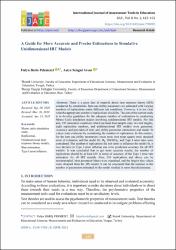A guide for more accurate and precise estimations in simulative unidimensional IRT models
Citation
Baris Pekmezci, F. & Şengül Avşar, A. (2021). A Guide for More Accurate and Precise Estimations in Simulative Unidimensional IRT Models . International Journal of Assessment Tools in Education , 8 (2) , 423-453. https://doi.org/10.21449/ijate.790289Abstract
There is a great deal of research about item response theory (IRT) conducted by simulations. Item and ability parameters are estimated with varying numbers of replications under different test conditions. However, it is not clear what the appropriate number of replications should be. The aim of the current study is to develop guidelines for the adequate number of replications in conducting Monte Carlo simulation studies involving unidimensional IRT models. For this aim, 192 simulation conditions which included four sample sizes, two test lengths, eight replication numbers, and unidimensional IRT models were generated. Accuracy and precision of item and ability parameter estimations and model fit values were evaluated by considering the number of replications. In this context, for the item and ability parameters; mean error, root mean square error, standard error of estimates, and for model fit; M-2, RMSEA(2), and Type I error rates were considered. The number of replications did not seem to influence the model fit, it was decisive in Type I error inflation and error prediction accuracy for all IRT models. It was concluded that to get more accurate results, the number of replications should be at least 625 in terms of accuracy of the Type I error rate estimation for all IRT models. Also, 156 replications and above can be recommended. Item parameter biases were examined, and the largest bias values were obtained from the 3PL model. It can be concluded that the increase in the number of parameters estimated by the model resulted in more biased estimates.


















